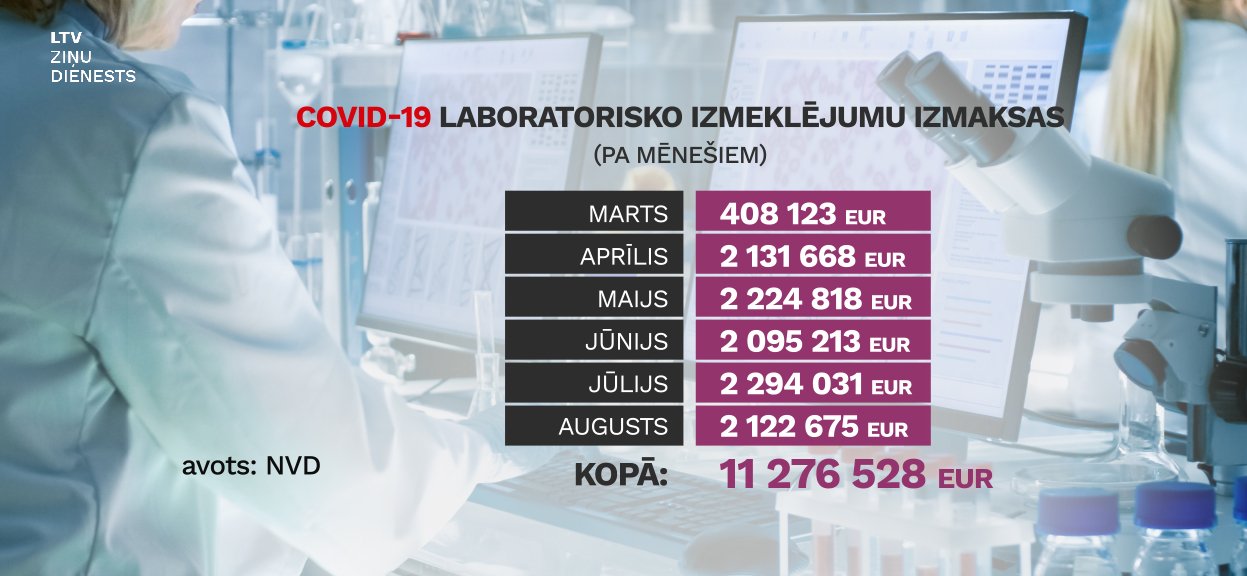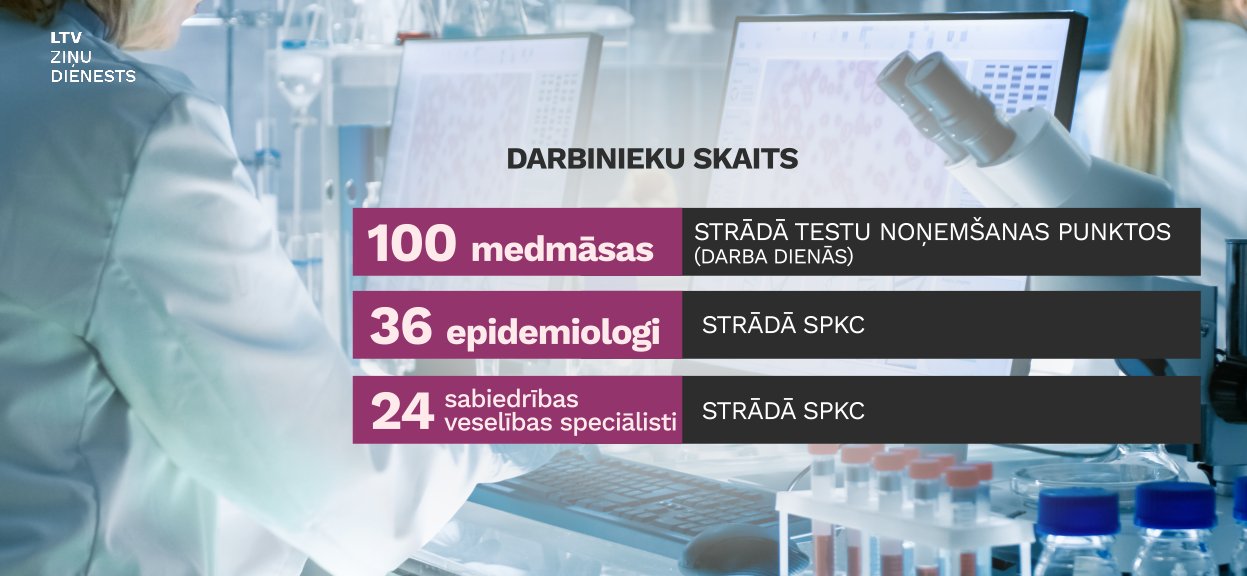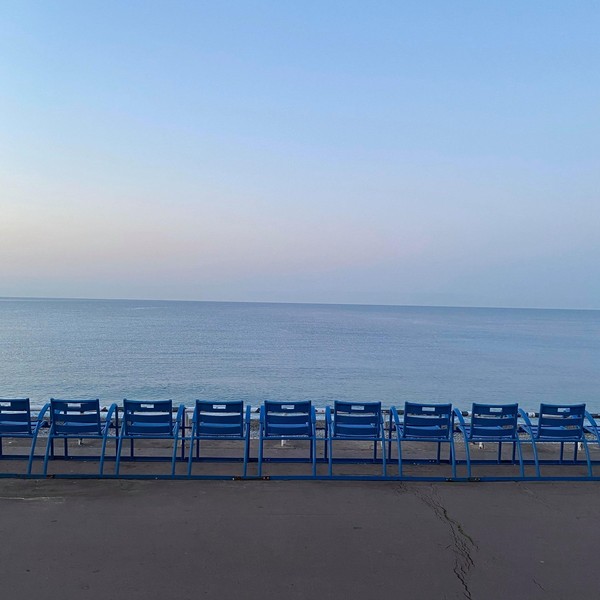IN SHORT:
- Since the summer, free Covid-19 tests have been available to everyone.
- The number of tests gradually increased; records reached – more than 5,000 tests per day.
- Politicians have indicated that 4,000 tests a day is the optimal number of tests.
- Long queues were formed for the tests – from 5 to 11 days.
- Reserves of test reagents would suffice for even greater test capacity.
- So far, 11 million euros have been spent on tests, but there is no shortage of money.
- The problem lies in staff shortages.
- There is a lack of those who take test samples, work in the laboratory, also SPKC overloaded.
- Specialist: People work overtime, they are at risk of burnout.
- Within two weeks, he hopes to split the flow of patients and reduce queues.
A few months ago, politicians and epidemiologists called on the public to be more active and to Perform Covid-19 Tests |, for their own and others’ safety. In addition one in five patients with Covid-19 does not experience any symptoms – no fever, no sore throat or, for example, loss of smell and taste. So a person can be sick without even knowing it.
As the prevalence of Covid-19 increased, so did people’s desire and need for testing. For example, in the last 24 hours, a record has been reached – 5,510 coronavirus tests were performed, exceeding last Friday’s record – 5,332 tests in one day.
Back in the summer, on average, just over a thousand people went to Covid-19 test points in one day, interest increased with each passing month, with more than 2,000 people checked every day in September.
But this month, the data collected by Thursday, October 22 inclusive, the number of people tested has increased several times, reaching 4,000 every day.
Politicians have indicated that this is the optimal number of tests.
But queues began to form on the tests. On Thursday, when applying for another state-paid Covid-19 test, regardless of the signs of the disease, you may have to wait five to eight days in Riga, 10 days in Jēkabpils and Valmiera, and 11 days in Jelgava.
Private laboratories compile their own queues, where waiting times can be shorter.
–
Sergei Nikichin, coordinator of the Covid-19 laboratory network, said it was time to eliminate long queues. It has been decided not to pay for the tests at all and to divide the patients into two different lines.
The number and reserves of test reagents are sufficient. And in fact, the reagent would suffice for even greater testing power.
“There is currently enough reagent for both sampling and testing. Its average capacity is 6,000 and even more we can test, taking into account all laboratories. There are both those reagents and equipment to be tested. But, of course, here it should be borne in mind that these examinations are not so cheap, and
these examinations cost the state about 200,000 euros a day. It’s not a small amount either, “said Nikišin.
At the very beginning of the pandemic, in March, the collection and processing of Covid-19 analyzes cost the country less than half a million euros a month, but since April more than two million euros have been spent every month.
In total, more than € 11 million has been spent so far, not counting September and October, when testing capacity has increased several times. Data for these autumn months are not yet available.
In addition, 11 million does not include additional costs – salaries of Covid-19 call center staff, operation of tents, home visits.

–
The National Health Service explained that the money for Covid-19 examinations is allocated from the budget for contingencies. At the end of the month, laboratories shall submit a report on the work performed, indicating the type, number and cost of the test. These data are then collected by the NSS and further decided by the Cabinet of Ministers on the disbursement of money. This procedure is repeated every month, and there is no reason to worry that the money has run out.
The problem is the lack of staff.
A total of 100 nurses currently work at all Covid-19 test collection points, each serving at least 50 people per day, according to statistics.
The number of nurses in laboratories varies on weekends, but much less than on weekdays, so the number of tests taken on Saturdays and Sundays is usually even halved. Laboratories also lack staff to process samples, while the Center for Disease Prevention and Control complains of congestion, as the number of positive cases of Covid-19 increases, so does the number of contacts and a lot of work is needed to identify the chains and sources of infection.
There, this work now rests on the shoulders of 36 epidemiologists and 24 public health professionals, bringing the total to 60 people calling thousands of other people and forcing staff from other departments to come to the rescue.

–
“If we want to increase the number of tests, then we need to think of some ways for us to get their staff. If we are just talking about sampling, there are 100 nurses, but all laboratories also have laboratory specialists inside who test those samples, and here the laboratories also work around the clock and on the verge of depletion to ensure a very large influx.
Currently, these points also work outside their working hours. People stay longer. People work overtime, ”said Nikišin.
And this in turn creates problems such as burnout syndrome and more. Over the next two weeks, it is planned to carefully divide patients into two rows, giving preference to those who will be referred by a doctor. These two weeks will then be used to analyze how the record is formed and whether long queue problems can be solved in this way.
CONTEXT:
From next week’s Covid-19 tests will be free only for those peoplewhich will be sent for testing by a GP or other medical professional. Thus, priority is given to testing patient contacts and patients with Covid-19-specific symptoms, as well as people who need the test before elective surgery. Others, who want to check, will wait in a longer queue and pay for the analyzes themselves.
GPs only agree to the system temporarily. The new procedure will run until November 8.
–


